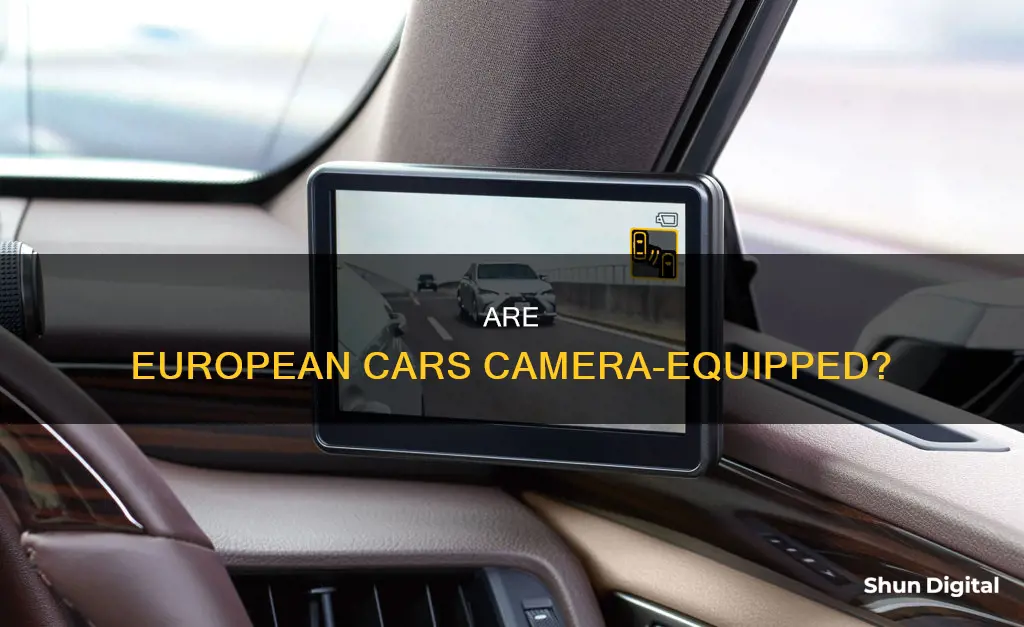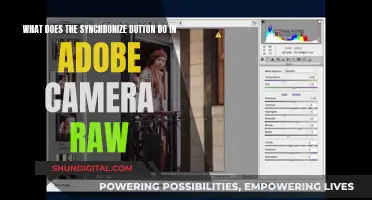
Dashcams and other cameras are becoming an increasingly common feature in cars across the world, including in Europe. While some brands such as Tesla, BMW, and Mercedes-Benz offer dashcam technology on most of their products, others like Lucid do not currently provide video recording capability. In 2022, the EU introduced reversing cameras as one of 15 new mandatory safety requirements for new vehicles, but it is unclear whether all cars in Europe are equipped with cameras.
| Characteristics | Values |
|---|---|
| Are cameras mandatory in European cars? | Yes, the EU introduced reversing cameras as a requirement for new vehicles in 2022. |
| Types of cameras | Reversing cameras, side-view cameras, dashcams, and cameras in place of traditional side-view mirrors. |
| Benefits of cameras | Cameras can improve safety, reduce blind spots, and assist with parking and manoeuvring. They can also provide evidence in the event of a crash, road rage incident, or car security breach. |
| Drawbacks of cameras | Cameras can distort perspective, making it harder to line up the car during parking or manoeuvring. They can also be affected by adverse weather conditions, such as snow, rain, or dirt, and introduce additional points of failure. |
| Examples of cars with built-in cameras | Audi E-tron, BMW (Drive Recorder system), Mercedes-Benz, Tesla, Toyota, Lexus, and Subaru. |
What You'll Learn

EU safety requirements for new vehicles
The EU's 'New Vehicle General Safety Regulation', also known as GSR2 or Regulation (EU) 2019/2144, amends the minimum performance standards for motor vehicles in the EU, introducing new required Advanced Driver Assistance Systems (ADAS). These include:
- Intelligent Speed Assist (ISA): This feature recognises traffic signs and provides an overspeed warning. ISA uses a forward-facing camera mounted in the windscreen to detect traffic signs and speed limits. If the speed limit is exceeded, the driver is given visual and audio feedback.
- Autonomous Emergency Braking (AEB): AEB is a collision avoidance feature that uses forward-facing cameras, RADARs, and other sensor technologies to prevent collisions. It scans the forward path of the vehicle for potential impact and applies braking to avoid or mitigate a collision.
- Driver Drowsiness and Attention Warning (DDAW): DDAW uses a driver-facing camera to detect the driver's gaze position and measure alertness. It alerts the driver when they look away from the road for too long or if drowsiness is detected.
- Emergency Lane Keeping Systems (ELKS): ELKS uses forward-facing cameras and RADARs to prevent a vehicle from veering out of its lane. It detects when a driver crosses lane markings and applies corrective steering to remain in the lane.
In addition to these ADAS features, GSR2 also mandates the following safety technologies:
- Alcohol Interlock Installation Facilitation (AIIF): This facilitates the installation of alcohol interlock devices, which prevent driving under the influence of alcohol.
- Event Data Recorder (EDR): Also known as a black box, it records and stores vehicle data before, during, and after a road traffic collision.
- Electronic Stability Programme (ESP): ESP helps prevent a loss of control during cornering and emergency steering by stabilising the vehicle.
- Emergency Stop Signal (ESS): When brakes are applied forcefully, the rear indicator lights flash to alert other vehicles.
- Reversing Detection Systems (RD): This system alerts drivers to the presence of people or objects at the rear of the vehicle to avoid collisions when reversing.
- Tyre Pressure Monitoring Systems (TPMS): TPMS monitors tyre air pressure and provides real-time feedback to the driver to prevent accidents caused by under-inflated tyres.
- Cybersecurity: With the increase in connected vehicles, robust cybersecurity is necessary to prevent theft.
- Advanced Driver Distraction Warning (ADDW): This system warns the driver and helps them stay focused on the traffic situation.
The EU is committed to enhancing road safety and reducing casualties, and these regulations are expected to have a significant impact, similar to the introduction of safety belts. While some of these technologies are already present in high-end vehicles, the new regulations raise the safety level across all new vehicles, including cars, vans, trucks, and buses.
The Evolution of Traffic Cameras: Computer-Operated Origins
You may want to see also

Dashcams in cars
Dashcams are a great way to capture evidence in the event of an accident, or to record footage of an interesting event while on the road. They are also useful for recording journeys, which can be handy for those wanting to review a road trip or commute, or for professional drivers who need to keep a record of their journeys.
Dashcams come in a variety of forms, from basic front-facing cameras to multi-camera systems that record the interior of the car and the road ahead. Some dashcams are built into the car's rear-view mirror, while others are mounted on the windscreen or dashboard. They can be powered by the car's cigarette lighter socket or, in some cases, hardwired into the car's electrical system.
When choosing a dashcam, it is important to consider the resolution and quality of the camera, as well as any additional features such as GPS, emergency service alerts, and radar detectors. It is also worth considering the ease of use of the camera and any companion apps.
In recent years, the EU has introduced a number of technology requirements for new vehicles, including some relating to cameras and driver aids. For example, from 2022, all new cars must be fitted with a reversing camera or detection system. However, it is not a requirement for all cars in Europe to be equipped with dashcams or other camera systems.
Dashcams are widely available online and in electronics stores, with prices ranging from around $50 to well over $500. When purchasing a dashcam, it is important to check the specifications and features to ensure that it meets your needs. Some models may also require the purchase of additional accessories, such as a memory card, to function properly.
Troubleshooting Lytro Camera Charging Issues
You may want to see also

Cameras replacing mirrors
The use of cameras instead of side mirrors in cars is an emerging trend in the automotive industry. While some manufacturers have been eager to adopt this technology, it has not been legalised in certain countries, including the United States. However, there is a growing interest in exploring the potential benefits of utilising cameras as a replacement for traditional side-view and rearview mirrors.
The primary advantage of this technological shift is the improvement in aerodynamics. By replacing the bulky side mirrors with sleek cameras and thin stalks, vehicles experience a reduction in drag, resulting in enhanced efficiency, increased visibility, and a decrease in wind noise. This is especially beneficial for electric vehicles, as the improved aerodynamics contribute to extended mileage per kWh and a quieter ride.
Another benefit of camera systems is the expanded field of view they offer. Drivers can select between "normal" and "wide" views, with the latter reducing blind spots by up to 50%. This enhanced visibility improves safety, particularly during lane changes and manoeuvres. Additionally, the camera systems provide better visibility at night and in poor weather conditions.
Despite these advantages, there are several factors delaying the widespread adoption of camera systems. One significant concern is the cost. Side mirrors are relatively inexpensive to install and repair, whereas camera systems incur higher upfront costs and maintenance expenses. Moreover, camera systems rely on capturing and transmitting images to a separate display screen, introducing the possibility of a delay in information delivery. In driving scenarios, every second is crucial, and such delays can pose safety risks.
Furthermore, the reliability of camera systems is a consideration. A cracked side mirror can still be used, but a malfunctioning camera can leave the driver blind on the road. The repair or replacement of cameras may also be more time-consuming and costly. Enforcing traffic violations related to camera systems may also be more challenging for law enforcement officers.
While the concept of cameras replacing mirrors in cars offers several advantages, there are legitimate concerns about cost, reliability, and potential delays in information delivery. These factors have likely contributed to the cautious approach taken by regulatory bodies in legalising the use of camera systems as a replacement for traditional mirrors.
Surveillance Cameras in NYC Apartments: What's Legal?
You may want to see also

Cameras for autonomous driving
Cameras are a critical component of autonomous driving technology, enabling vehicles to "see" and understand their surroundings. They are one of the three main types of sensors used for autonomous vehicle guidance systems, alongside radar and lidar.
Cameras used in autonomous cars are specialised image sensors that detect the visible light spectrum reflected from objects. They can capture images of the entire environment around the vehicle and detect, classify, and measure the distance between objects on the road. This information allows an autonomous vehicle to avoid hitting pedestrians or other vehicles.
One example of a camera for autonomous driving is the MPC3 (Multi-Purpose Camera) developed by Bosch. This camera is mounted behind the windshield between the headliner and rear-view mirror, and it uses AI to enable vehicles to recognise their surroundings more quickly and reliably. The MPC3 employs three paths to identify objects:
- The classifier: This path uses machine learning to recognise and classify specific objects such as vehicles and pedestrians.
- The optical flow: This path uses imaging techniques to detect raised objects bounding the road, such as curbstones, and to compute three-dimensional structures.
- Artificial intelligence: This path enables the camera to distinguish the roadway from the shoulder or identify discrete objects using neural networks and semantic segmentation.
While cameras are essential for autonomous driving, they do have some limitations. Similar to the human eye, their ability to capture clear images can be impacted by poor weather and lighting conditions, such as rain, fog, or snow. To overcome this limitation, thermal cameras can be used, but they also require multiple cameras on the vehicle to render realistic images, generating a large amount of data that needs to be processed.
In conclusion, cameras play a crucial role in autonomous driving by providing visual data and object recognition capabilities. However, they need to be complemented by other sensors like radar and lidar to ensure safe and reliable operation in various conditions. The combination of these technologies brings us closer to achieving fully autonomous driving capabilities.
Fight Traffic Camera Tickets: Maryland's Laws and Your Rights
You may want to see also

Privacy concerns with car cameras
Data Collection
Car cameras can collect a vast amount of personal data, including medical and genetic information, as well as details about a person's sex life, driving habits, and location. This data can be used to make "inferences" about a person's intelligence, abilities, and interests, which raises concerns about the potential for profiling and discrimination. Additionally, car companies often share or sell this data to third parties, including service providers, data brokers, and other businesses, without explicit consent from the individuals involved.
Privacy Invasion
In-car cameras can invade the privacy of not only the driver but also passengers and passers-by. For example, Tesla's "Sentry Mode", designed to record suspicious activity when the car is parked, has been criticised for allowing owners to spy on people walking by or inside their homes. This has raised concerns about the potential for misuse of camera footage, such as stalking or harassment.
Security Risks
The security measures surrounding car camera data are often inadequate, leaving this sensitive information vulnerable to hackers, malicious actors, or unauthorised access by government or law enforcement agencies. This could have serious implications for the safety and privacy of individuals.
Lack of Transparency and Control
Car companies often provide vague or confusing privacy policies, making it difficult for consumers to understand how their data is being used and shared. Additionally, individuals often have little to no control over their personal data, with many companies not offering a right to have data deleted or opting out of data collection without disabling important vehicle features.
Misuse by Corporations
There is a risk that car companies may misuse the data collected from in-car cameras for purposes beyond safety and security, such as tracking driver behaviour for marketing or other business purposes. For example, Tesla has been accused of using footage to blame drivers for crashes instead of addressing the limitations of its Autopilot system.
Xfinity Cameras: Who Makes Them?
You may want to see also
Frequently asked questions
No, but some cars in Europe are equipped with cameras. For example, some Audi E-trons in the European market have camera-based mirrors.
Cameras can be used in place of traditional side-view mirrors to reduce blind spots. They can also be used as dashcams to record footage in the event of a crash, road rage incident, or car security event.
Cameras can provide a wider field of view and reduce aerodynamic drag, leading to improved fuel efficiency.
Tesla, BMW, Mercedes-Benz, Toyota, Lexus, and Subaru offer built-in dashcam technology on most of their products.
Cameras can distort the perspective, making it harder to line up the car when parking or maneuvering. They are also more susceptible to being obscured by snow, rain, and dirt.







